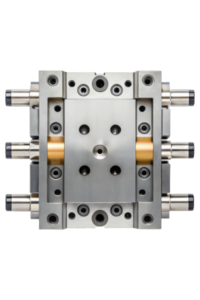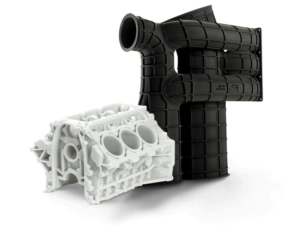by Matt Dietzman, Sales Enablement Manager
Designing for CNC machining demands precision and foresight to ensure optimal functionality and manufacturability of components. Internal radii, hole design, wall thickness, and tolerance specifications stand as pivotal factors influencing the quality and efficiency of CNC-produced parts.
In this blog, we’ll explore four crucial strategies that can significantly enhance the design process for CNC machining and offer insights into how these elements shape the final product’s quality and performance.
1. Include sufficient radii for internal corners.
Often overlooked, but fundamentally crucial, is the incorporation of proper radii in part designs. Radii, specifically internal ones, significantly impact the manufacturability, quality, and overall functionality of CNC parts. The below reasons explain how incorporating proper internal radii into a CNC part can be beneficial.
Enhanced Machinability
Sharp internal corners pose significant challenges during CNC machining. These corners necessitate tooling approaches that increase the likelihood of tool breakage, reduced tool life, and slower machining speeds. Implementing proper radii mitigates these issues by allowing tool paths to smoothly navigate along the part’s features. This improves tool life, minimizes stress concentrations, and ultimately enhances the machinability of the part.
Durability and Strength
Beyond just facilitating machining, adequate radii contribute to the structural integrity of CNC parts. Sharp corners act as stress concentration points, potentially compromising the part’s strength. By incorporating sufficient radii, these stress concentration areas are alleviated, distributing stress more evenly throughout the part. As a result, the part is less prone to premature failure or deformation, ensuring enhanced durability.
Quality and Aesthetics
Proper radii not only bolster the structural aspects but also contribute to the overall quality and aesthetics of the finished part. Smoother transitions between surfaces due to well-designed radii result in improved surface finishes. This aspect is particularly crucial for parts where aesthetics are significant, such as consumer products or components with visible surfaces.
Summary of Internal Radii
Internal radii play a crucial part in CNC part design for manufacturability. A general guideline for implementing the internal radii is to have the depth of pocket follow a 1:8 ratio in relation to the internal radii. Following this guideline will help your part succeed and provide the part with all the benefits listed above.
2. Have the Proper Hole Design
Utilize Standard Drill Sizes
Adopting standard drill sizes in hole design streamlines the manufacturing process. These sizes align with readily available tools, reducing the need for custom tooling and minimizing lead times and costs. Standardized drill bits ensure consistent hole dimensions and precision, facilitating smoother and more efficient CNC operations. Also, when possible, try to align all holes, fasteners, and other screw threads to be the same on the part. Doing so reduces the number of drill spindles and changes needed for machining and will decrease your costs and lead times.
Hole Location and Size Matters
Proper hole location is crucial to prevent cosmetic defects, structural failures, and allowing the manufacturer to machine the holes properly. When picking the location for the hole in the part design, try to stay away from holes near the edges of the part. Having a hole near the edge can cause the hole to bulge out making a cosmetic defect or making the hole not structurally sound, especially if it is a threaded hole.
In addition, if making a threaded hole, keep in mind that a smaller number of threads can likely take most of the required load for your project. The first four pitches will take most of the load and everything longer than the diameter of the hole is likely unnecessary. Try to avoid holes of Ø3 mm (.040”) or smaller as these holes are more susceptible to breakage. Lastly, always leave space for the drilling tool in the part design. This means having at least a 12mm (0.5”) drill center to the wall or drilled depth.
Keep the Depth of the Hole in Mind
While CNC drilling is designed for vertical cutting, if the hole is too deep the chances of a drill bit breaking drastically increases. It is recommended for the maximum depth of drilling to be no more than 8-12 times the nearest drill bit diameter. Additionally, it is important to account for the conical drill point at the bottom of the hole when drilling a blind hole. The drill point will not count towards the length of your hole, so this requires adding some additional depth to the hole to account for the drill point. Quickparts recommends making the hole depth 25% longer than the necessary depth to a blind hole to account for the drill point and any chips from the drilling, which may collect at the bottom of the hole.
3. Implement Proper Wall Design
Wall Design Guidelines
When trying to push the design limits for the CNC part to be thinner, lighter, and better performing, it is important to keep in mind wall thickness guidelines. A general rule of thumb is to keep the wall thickness above 0.030” (or ~0.750mm) to avoid issues. It is possible to go thinner than this based on factors such as material selection, wall height to thickness ratio, wall height to length ratio, and the part geometry, so it is important to consult an expert for your individual design.
Results of having thin walls
The main result of having thin walls is having the vibrations from the machining process affect the part. This can also be referred to as chatter. If this chatter is significant and the walls are thin it can either cause cosmetic defects in the part design or more likely cause dimensional issues with the part.
4. Refrain from Over-Tightening Tolerances.
Why is Tolerancing Important?
Over-tolerancing — specifying tighter tolerances than necessary — poses challenges during CNC machining. This approach often requires specialized tooling or processes to achieve, subsequently elevating manufacturing costs. Additionally, over-tolerancing may lead to increased scrap rates or the need for rework, further impacting production timelines and expenses.
Guidelines for Tolerances
The standard shop tolerance at Quickparts will be ±0.005” (0.125mm). This is not to say the tolerance cannot be tighter, but this will be the most cost and time efficient tolerance. If need be, the tolerance can go as tight as ±0.001” (0.250mm), but there will likely be an increase in costs and lead times. In addition to just length, width, and height tolerance, Quickparts is also more than willing to review geometric dimensioning and tolerancing (GD&T) on the customer’s drawing. Some examples of GD&T that could be added to the drawing to make your part more dimensionally accurate would include things like flatness, cylindricity, and concentricity.
Conclusion
Within the domain of CNC machining, the intricacies of design profoundly impact the success of the manufacturing process. By embracing practices that prioritize internal radii for enhanced machinability, standardizing hole designs for efficiency, optimizing wall thickness for structural integrity, and thoughtfully specifying tolerances, designers pave the way for superior CNC-produced components. The meticulous consideration of these factors not only refines the manufacturing process but also ensures cost-effective and timely production of high-quality parts. Embracing these optimization techniques allows for the seamless integration of design and manufacturing, unlocking the full potential of CNC technology and resulting in exceptional precision and functionality for the product.


